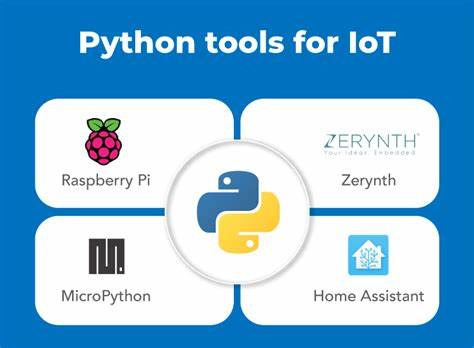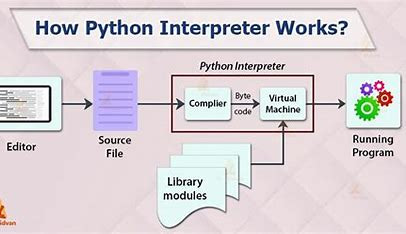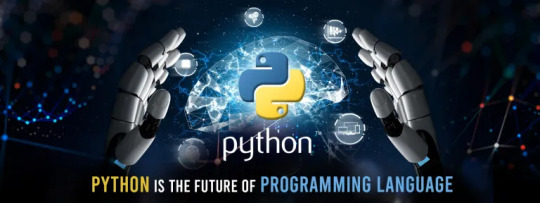#technology with python
Explore tagged Tumblr posts
Text
know Python.
A Look into the Python Programming Language
Introduction
Python has become a dominant force in the world of programming. This versatile language is lauded for its readability, extensive libraries, and vast applications. This article delves into the history of Python, explores the reasons why it's a valuable skill to learn, and examines its impact on the world today and tomorrow.
History
Guido van Rossum, a Dutch programmer, designed Python in the late 1980s. His goal was to create a language that was both powerful and easy to learn, emphasizing code readability. Inspired by the humor group Monty Python, he named the language after them. Python's first official release came in 1991, and it has grown steadily in popularity ever since.

Why Learn Python?
There are numerous reasons why Python is a great language to pick up. Here are a few key points:
Readability: Python's syntax is clear and concise, resembling natural language. This makes it easier to learn and maintain code compared to languages with complex syntax.
Versatility: Python is a general-purpose language, meaning it can be used for a wide range of tasks. From web development and data science to machine learning and automation, Python excels in numerous domains.
Extensive Libraries: The Python ecosystem boasts a vast collection of libraries and frameworks. These pre-written tools provide users with functionalities for specific tasks, saving development time.
Large Community: Python has a vibrant and supportive online community. This means there's an abundance of resources and help available for learners and experienced programmers alike.
Python's Global Reach
Python's influence extends far and wide. Here are some examples of how countries around the world are leveraging Python's power:
The United States: Tech giants like Google, Facebook, and Netflix utilize Python for various purposes, including web development, data analysis, and machine learning.
India: Python is a popular choice for software development and data science in India, a country experiencing a major tech boom.
China: China's tech sector is also embracing Python, particularly in areas like artificial intelligence and scientific computing.
The Future of Python
With its adaptability and ease of use, Python is well-positioned for a prominent role in the future of technology. Here are some potential areas where Python might play a key role:
Artificial Intelligence (AI): Python's established libraries like TensorFlow and PyTorch make it a go-to language for developing AI applications.
Data Science and Machine Learning: Python's data manipulation and analysis capabilities will continue to be crucial for these rapidly evolving fields.
Internet of Things (IoT): As more devices become interconnected, Python's potential for scripting and automating tasks within IoT systems will be increasingly valuable.

Recent Advancements with Python
Python has been instrumental in the development of several cutting-edge technologies. A few notable examples include:
Self-Driving Cars: Python plays a role in developing the control systems and machine learning algorithms used in self-driving cars.
Facial Recognition Software: Python libraries are used to create and train facial recognition systems.
Natural Language Processing (NLP): Python is a popular choice for developing NLP applications, such as chatbots and machine translation tools.

Working Structure
Source Code:
You write Python code in plain text files with the .py extension. This code is human-readable, resembling natural language for easy understanding and modification.
Compilation (Bytecode):
Unlike some languages that directly translate to machine code, Python utilizes an intermediate step. The Python compiler converts your source code into bytecode, a lower-level representation. Bytecode files typically have the .pyc or .pyo extension.
Python Virtual Machine (PVM):
The bytecode can't be directly executed by your computer's hardware. The Python Virtual Machine (PVM) acts as an interpreter, reading and executing the bytecode instructions. The PVM manages memory allocation and provides an environment for your code to run.
Libraries and Modules:
Python boasts a rich collection of pre-written code called libraries and modules. These modules contain functions, classes, and variables that provide functionalities for various tasks. You can import these modules into your code to leverage their capabilities, saving development time.
Execution:
When you run a Python script, the interpreter reads the bytecode line by line. It executes the instructions, interacting with libraries and modules as needed. The output of your code is then displayed on the console or used within the program itself.

Conclusion
Python's impact on the technological landscape is undeniable. Its readability, vast ecosystem of libraries, and diverse applications make it a language well worth learning. As technology continues to evolve, Python is sure to remain a powerful tool that shapes the future.

0 notes
Text

Something cute for the coders. If y’all want this on redbubble let me know
#python#coding#software development#software developers#coder#technology#artists on tumblr#digital artist#digital art#original illustration#original drawing#my art#snake#snake tw#bug tw#notstarstuff
11 notes
·
View notes
Text

27-Year-Old EXE becomes Python - AI-assisted reverse engineering 🤖⚡💾🐍 https://blog.adafruit.com/2025/02/27/27-year-old-exe-becomes-python-in-minutes-with-claude-ai-assisted-reverse-engineering/
#reverseengineering#ai#python#machinelearning#technews#coding#artificialintelligence#programming#innovation#automation#technology#softwaredevelopment#aiassisted#dataconversion#retrocomputing#computerscience#techtrends#cybersecurity#hacking#opensource#techcommunity#developer#aiintech#digitaltransformation#programmerslife#coders#futuretech#softwareengineering#oldtomew#modernization
7 notes
·
View notes
Text
I desprately need someone to talk to about this
I've been working on a system to allow a genetic algorithm to create DNA code which can create self-organising organisms. Someone I know has created a very effective genetic algorithm which blows NEAT out of the water in my opinion. So, this algorithm is very good at using food values to determine which organisms to breed, how to breed them, and the multitude of different biologically inspired mutation mechanisms which allow for things like meta genes and meta-meta genes, and a whole other slew of things. I am building a translation system, basically a compiler on top of it, and designing an instruction set and genetic repair mechanisms to allow it to convert ANY hexadecimal string into a valid, operable program. I'm doing this by having an organism with, so far, 5 planned chromosomes. The first and second chromosome are the INITIAL STATE of a neural network. The number and configuration of input nodes, the number and configuration of output nodes, whatever code it needs for a fitness function, and the configuration and weights of the layers. This neural network is not used at all in the fitness evaluation of the organism, but purely something the organism itself can manage, train, and utilize how it sees fit.
The third is the complete code of the program which runs the organism. Its basically a list of ASM opcodes and arguments written in hexadecimal. It is comprised of codons which represent the different hexadecimal characters, as well as a start and stop codon. This program will be compiled into executable machine code using LLVM IR and a custom instruction set I've designed for the organisms to give them a turing complete programming language and some helper functions to make certain processes simpler to evolve. This includes messages between the organisms, reproduction methods, and all the methods necessary for the organisms to develop sight, hearing, and recieve various other inputs, and also to output audio, video, and various outputs like mouse, keyboard, or a gamepad output. The fourth is a blank slate, which the organism can evolve whatever data it wants. The first half will be the complete contents of the organisms ROM after the important information, and the second half will be the initial state of the organisms memory. This will likely be stored as base 64 of its hash and unfolded into binary on compilation.
The 5th chromosome is one I just came up with and I am very excited about, it will be a translation dictionary. It will be 512 individual codons exactly, with each codon pair being mapped between 00 and FF hex. When evaulating the hex of the other chromosomes, this dictionary will be used to determine the equivalent instruction of any given hex pair. When evolving, each hex pair in the 5th organism will be guaranteed to be a valid opcode in the instruction set by using modulus to constrain each pair to the 55 instructions currently available. This will allow an organism to evolve its own instruction distribution, and try to prevent random instructions which might be harmful or inneficient from springing up as often, and instead more often select for efficient or safer instructions.
#ai#technology#genetic algorithm#machine learning#programming#python#ideas#discussion#open source#FOSS#linux#linuxposting#musings#word vomit#random thoughts#rant
7 notes
·
View notes
Text

This is part of a new project I am doing for a Facebook app that can alert someone when there is suspicious activity on their account, and block people who post rude comments and hate speech using a BERT model I am training on a dataset of hate speech. It automatically blocks people who are really rude / mean and keeps your feed clean of spam. I am developing it right now for work and for @emoryvalentine14 to test out and maybe in the future I will make it public.
I love NLP :D Also I plan to host this server probably on Heroku or something after it is done.
#machine learning#artificial intelligence#python programming#programmer#programming#technology#coding#python#ai#python 3#social media#stopthehate#lgbtq community#lgbtqia#lgbtqplus#gender equality
74 notes
·
View notes
Text

Robotic Process Automation (RPA) enhances business efficiency by automating repetitive tasks, freeing up employees for more strategic work. It improves accuracy, reduces operational costs, and boosts productivity across industries.
#artificialintelligence#ai#machinelearning#aiart#digitalart#technology#art#aiartcommunity#midjourney#datascience#generativeart#innovation#tech#deeplearning#python#midjourneyart#aiartwork#aiartist#programming#robotics#bigdata#artoftheday#coding#aiartists#digitalartist#business#iot#midjourneyai#artwork#stablediffusion
3 notes
·
View notes
Text

Are you looking to elevate your online presence and drive #businessgrowth? Our custom #webdevelopmentservices can help! At Pranathiss, we understand the importance of having a #website that accurately reflects your #brand and meets the needs of your #customers. Our expert team will work closely with you to create a custom solution that exceeds your expectations.
Learn more about our custom web #developmentservices and how they can benefit your #business: https://www.pranathiss.com/blog/custom-web-development-services-for-advanced-online-solutions/
#webdevelopment#webdesign#html#websitedesign#coding#programming#javascript#css#wordpress#marketing#websitedevelopment#branding#graphicdesign#socialmediamarketing#software#python#technology#design#softwaredeveloper#coder
10 notes
·
View notes
Text
How to Sort List of Tuples in Python | Python List Tutorial | Python Tutorials for Beginners
via IFTTT
youtube
View On WordPress
#coding#computer science#india#information technology#learning#online#programming#Python#teaching#tutorial#Youtube
2 notes
·
View notes
Text
What’s the Big Deal About Python?
If you’ve been around the tech world even for a minute, you’ve probably heard people raving about Python. No, not the snake, we’re talking about the programming language. But what’s so special about it? Why is everyone from beginner coders to AI researchers using Python like it’s their best friend? Let’s break it down in simple words.

Easy to Learn, Easy to Use
First things first, Python is super easy to learn. The code looks almost like regular English, which means you don’t have to memorize weird symbols or endless rules. If you’re just starting your programming journey, Python won’t scare you away.
For example, printing a sentence in Python is as simple as:

That’s it. No extra setup, no confusing syntax. It just works.
Used Everywhere
Python isn’t just for small scripts or learning projects. It’s everywhere, web development, data science, automation, artificial intelligence, game development, even robotics.
Big companies like Google, Netflix, and Instagram use Python behind the scenes to make their products work better.
Huge Library Support
One of the best things about Python is its rich library ecosystem. Libraries are like pre-written tools that help you do complex stuff without writing all the code yourself. Want to analyze data? Use Pandas. Want to build a web app? Try Django or Flask. Want to build a chatbot or train a machine learning model? There’s TensorFlow and PyTorch for that.
Great Community
Python has a massive community. That means if you ever get stuck, there’s a good chance someone has already solved your problem and posted about it online. You’ll find tons of tutorials, forums, and helpful folks willing to guide you.
Not the Fastest, But Fast Enough
Python isn’t the fastest language out there — it’s not meant for super high-speed system-level programming. But for most tasks, it’s more than fast enough. And if you really need to speed things up, there are ways to connect Python with faster languages like C or C++.
So, Should You Learn Python?
Absolutely. Whether you’re a student, a hobbyist, or someone switching careers, Python is a great place to start. It’s beginner friendly, powerful, and widely used. You’ll be surprised how much you can build with just a few lines of Python code.
2 notes
·
View notes
Text
Python Programming Language: A Comprehensive Guide
Python is one of the maximum widely used and hastily growing programming languages within the world. Known for its simplicity, versatility, and great ecosystem, Python has become the cross-to desire for beginners, professionals, and organizations across industries.
What is Python used for

🐍 What is Python?
Python is a excessive-stage, interpreted, fashionable-purpose programming language. The language emphasizes clarity, concise syntax, and code simplicity, making it an excellent device for the whole lot from web development to synthetic intelligence.
Its syntax is designed to be readable and easy, regularly described as being near the English language. This ease of information has led Python to be adopted no longer simplest through programmers but also by way of scientists, mathematicians, and analysts who may not have a formal heritage in software engineering.
📜 Brief History of Python
Late Nineteen Eighties: Guido van Rossum starts work on Python as a hobby task.
1991: Python zero.9.0 is released, presenting classes, functions, and exception managing.
2000: Python 2.Zero is launched, introducing capabilities like list comprehensions and rubbish collection.
2008: Python 3.Zero is launched with considerable upgrades but breaks backward compatibility.
2024: Python three.12 is the modern day strong model, enhancing performance and typing support.
⭐ Key Features of Python
Easy to Learn and Use:
Python's syntax is simple and similar to English, making it a high-quality first programming language.
Interpreted Language:
Python isn't always compiled into device code; it's far done line by using line the usage of an interpreter, which makes debugging less complicated.
Cross-Platform:
Python code runs on Windows, macOS, Linux, and even cell devices and embedded structures.
Dynamic Typing:
Variables don’t require explicit type declarations; types are decided at runtime.
Object-Oriented and Functional:
Python helps each item-orientated programming (OOP) and practical programming paradigms.
Extensive Standard Library:
Python includes a rich set of built-in modules for string operations, report I/O, databases, networking, and more.
Huge Ecosystem of Libraries:
From data technological know-how to net development, Python's atmosphere consists of thousands of programs like NumPy, pandas, TensorFlow, Flask, Django, and many greater.
📌 Basic Python Syntax
Here's an instance of a easy Python program:
python
Copy
Edit
def greet(call):
print(f"Hello, call!")
greet("Alice")
Output:
Copy
Edit
Hello, Alice!
Key Syntax Elements:
Indentation is used to define blocks (no curly braces like in different languages).
Variables are declared via task: x = 5
Comments use #:
# This is a remark
Print Function:
print("Hello")
📊 Python Data Types
Python has several built-in data kinds:
Numeric: int, go with the flow, complicated
Text: str
Boolean: bool (True, False)
Sequence: listing, tuple, range
Mapping: dict
Set Types: set, frozenset
Example:
python
Copy
Edit
age = 25 # int
name = "John" # str
top = 5.Nine # drift
is_student = True # bool
colors = ["red", "green", "blue"] # listing
🔁 Control Structures
Conditional Statements:
python
Copy
Edit
if age > 18:
print("Adult")
elif age == 18:
print("Just became an person")
else:
print("Minor")
Loops:
python
Copy
Edit
for color in hues:
print(coloration)
while age < 30:
age += 1
🔧 Functions and Modules
Defining a Function:
python
Copy
Edit
def upload(a, b):
return a + b
Importing a Module:
python
Copy
Edit
import math
print(math.Sqrt(sixteen)) # Output: four.0
🗂️ Object-Oriented Programming (OOP)
Python supports OOP functions such as lessons, inheritance, and encapsulation.
Python
Copy
Edit
elegance Animal:
def __init__(self, call):
self.Call = name
def communicate(self):
print(f"self.Call makes a valid")
dog = Animal("Dog")
dog.Speak() # Output: Dog makes a legitimate
🧠 Applications of Python
Python is used in nearly each area of era:
1. Web Development
Frameworks like Django, Flask, and FastAPI make Python fantastic for building scalable web programs.
2. Data Science & Analytics
Libraries like pandas, NumPy, and Matplotlib permit for data manipulation, evaluation, and visualization.
Three. Machine Learning & AI
Python is the dominant language for AI, way to TensorFlow, PyTorch, scikit-research, and Keras.
4. Automation & Scripting
Python is extensively used for automating tasks like file managing, device tracking, and data scraping.
Five. Game Development
Frameworks like Pygame allow builders to build simple 2D games.
6. Desktop Applications
With libraries like Tkinter and PyQt, Python may be used to create cross-platform computing device apps.
7. Cybersecurity
Python is often used to write security equipment, penetration trying out scripts, and make the most development.
📚 Popular Python Libraries
NumPy: Numerical computing
pandas: Data analysis
Matplotlib / Seaborn: Visualization
scikit-study: Machine mastering
BeautifulSoup / Scrapy: Web scraping
Flask / Django: Web frameworks
OpenCV: Image processing
PyTorch / TensorFlow: Deep mastering
SQLAlchemy: Database ORM
💻 Python Tools and IDEs
Popular environments and tools for writing Python code encompass:
PyCharm: Full-featured Python IDE.
VS Code: Lightweight and extensible editor.
Jupyter Notebook: Interactive environment for statistics technological know-how and studies.
IDLE: Python’s default editor.
🔐 Strengths of Python
Easy to study and write
Large community and wealthy documentation
Extensive 0.33-birthday celebration libraries
Strong support for clinical computing and AI
Cross-platform compatibility
⚠️ Limitations of Python
Slower than compiled languages like C/C++
Not perfect for mobile app improvement
High memory usage in massive-scale packages
GIL (Global Interpreter Lock) restricts genuine multithreading in CPython
🧭 Learning Path for Python Beginners
Learn variables, facts types, and control glide.
Practice features and loops.
Understand modules and report coping with.
Explore OOP concepts.
Work on small initiatives (e.G., calculator, to-do app).
Dive into unique areas like statistics technological know-how, automation, or web development.
#What is Python used for#college students learn python#online course python#offline python course institute#python jobs in information technology
2 notes
·
View notes
Text

:3
I love my life))))))
(Crying)
2 notes
·
View notes
Text
How to get into Coding!
Coding is very important now and in the future. Technology relies on coding and in the future you will need to know how to code to get a high-paying job. Many people consider having Computer Science field-related jobs, especially in AI. What if you are interested it in general or as a hobby? What if you don't know what you want to do yet for college?
Pick a language you want to learn: Personally, I started out with HTML and CSS. I recommend if you want to do web design HTML and CSS are good languages to start with. Otherwise, start with JavaScript or Python.
2. Find Resources: Basically you want to look at videos on YouTube, and take classes that have coding like AP CSP, AP CS A (harder class), Digital Information Technology, etc. You can also attend classes outside in the summer like CodeNinjas and use websites like code.org, freeCodeCamp, and Codecademy. Also, ask your friends for help too! You can find communities on Reddit and Discord as well.
3. Start Practicing: Practice slowly by doing small projects like making games for websites and apps. You can work with friends if you are still a beginner or need help. There's also open-source coding you can do!
4. Continue coding: If you don't continue, you will lose your skills. Be sure to always look up news on coding and different coding languages.
5. Certifications: If you are advanced in coding or want to learn more about technology, you can do certifications. This can cost a lot of money depending on what certification you are doing. Some school districts pay for your certification test. But if you take the test and pass, you can put it on your resume, and job recruiters/interviewers will be impressed! This can help with college applications and show initiative if you want a computer science degree. This shows you are a "master" of the language.
#tech#coding#learning#education#hobby#fun#jobs#high school#college#university#youtube#reddit#certification#javascript#java#python#html css#css#html#ap classes#ap csp#information technology#technology#computer science#programming#software engineering#web design#web development#discord chat#discord server
10 notes
·
View notes
Text

Python Isn’t Just a Language—It’s a Weapon. Learn It Loud in Kochi. 💻
You’re not here for basics. You’re here to build, break, and rebuild with purpose. At iROHUB Infotech, the Python course in Kochi is a full-throttle, no-fluff, real-world experience for those who are done playing safe. From zero to pro, you’ll write code that breathes life into automation, web apps, AI, and more — not in theory, but in the wild. You’ll work on real projects, face real challenges, and come out with skills employers actually want. This isn’t a tutorial playlist. It’s an evolution. If you’re ready to think logically and speak in Python, iROHUB is your battlefield.
Dare to code differently? This is your signal.
For more information, visit: https://www.irohub.com, [email protected]
#softwaretraininginstituteinkochi#python#ios#kochi#mobile app development#technology#tech#computer#smart tech
2 notes
·
View notes
Text
Why Python Will Thrive: Future Trends and Applications
Python has already made a significant impact in the tech world, and its trajectory for the future is even more promising. From its simplicity and versatility to its widespread use in cutting-edge technologies, Python is expected to continue thriving in the coming years. Considering the kind support of Python Course in Chennai Whatever your level of experience or reason for switching from another programming language, learning Python gets much more fun.

Let's explore why Python will remain at the forefront of software development and what trends and applications will contribute to its ongoing dominance.
1. Artificial Intelligence and Machine Learning
Python is already the go-to language for AI and machine learning, and its role in these fields is set to expand further. With powerful libraries such as TensorFlow, PyTorch, and Scikit-learn, Python simplifies the development of machine learning models and artificial intelligence applications. As more industries integrate AI for automation, personalization, and predictive analytics, Python will remain a core language for developing intelligent systems.
2. Data Science and Big Data
Data science is one of the most significant areas where Python has excelled. Libraries like Pandas, NumPy, and Matplotlib make data manipulation and visualization simple and efficient. As companies and organizations continue to generate and analyze vast amounts of data, Python’s ability to process, clean, and visualize big data will only become more critical. Additionally, Python’s compatibility with big data platforms like Hadoop and Apache Spark ensures that it will remain a major player in data-driven decision-making.
3. Web Development
Python’s role in web development is growing thanks to frameworks like Django and Flask, which provide robust, scalable, and secure solutions for building web applications. With the increasing demand for interactive websites and APIs, Python is well-positioned to continue serving as a top language for backend development. Its integration with cloud computing platforms will also fuel its growth in building modern web applications that scale efficiently.
4. Automation and Scripting
Automation is another area where Python excels. Developers use Python to automate tasks ranging from system administration to testing and deployment. With the rise of DevOps practices and the growing demand for workflow automation, Python’s role in streamlining repetitive processes will continue to grow. Businesses across industries will rely on Python to boost productivity, reduce errors, and optimize performance. With the aid of Best Online Training & Placement Programs, which offer comprehensive training and job placement support to anyone looking to develop their talents, it’s easier to learn this tool and advance your career.

5. Cybersecurity and Ethical Hacking
With cyber threats becoming increasingly sophisticated, cybersecurity is a critical concern for businesses worldwide. Python is widely used for penetration testing, vulnerability scanning, and threat detection due to its simplicity and effectiveness. Libraries like Scapy and PyCrypto make Python an excellent choice for ethical hacking and security professionals. As the need for robust cybersecurity measures increases, Python’s role in safeguarding digital assets will continue to thrive.
6. Internet of Things (IoT)
Python’s compatibility with microcontrollers and embedded systems makes it a strong contender in the growing field of IoT. Frameworks like MicroPython and CircuitPython enable developers to build IoT applications efficiently, whether for home automation, smart cities, or industrial systems. As the number of connected devices continues to rise, Python will remain a dominant language for creating scalable and reliable IoT solutions.
7. Cloud Computing and Serverless Architectures
The rise of cloud computing and serverless architectures has created new opportunities for Python. Cloud platforms like AWS, Google Cloud, and Microsoft Azure all support Python, allowing developers to build scalable and cost-efficient applications. With its flexibility and integration capabilities, Python is perfectly suited for developing cloud-based applications, serverless functions, and microservices.
8. Gaming and Virtual Reality
Python has long been used in game development, with libraries such as Pygame offering simple tools to create 2D games. However, as gaming and virtual reality (VR) technologies evolve, Python’s role in developing immersive experiences will grow. The language’s ease of use and integration with game engines will make it a popular choice for building gaming platforms, VR applications, and simulations.
9. Expanding Job Market
As Python’s applications continue to grow, so does the demand for Python developers. From startups to tech giants like Google, Facebook, and Amazon, companies across industries are seeking professionals who are proficient in Python. The increasing adoption of Python in various fields, including data science, AI, cybersecurity, and cloud computing, ensures a thriving job market for Python developers in the future.
10. Constant Evolution and Community Support
Python’s open-source nature means that it’s constantly evolving with new libraries, frameworks, and features. Its vibrant community of developers contributes to its growth and ensures that Python stays relevant to emerging trends and technologies. Whether it’s a new tool for AI or a breakthrough in web development, Python’s community is always working to improve the language and make it more efficient for developers.
Conclusion
Python’s future is bright, with its presence continuing to grow in AI, data science, automation, web development, and beyond. As industries become increasingly data-driven, automated, and connected, Python’s simplicity, versatility, and strong community support make it an ideal choice for developers. Whether you are a beginner looking to start your coding journey or a seasoned professional exploring new career opportunities, learning Python offers long-term benefits in a rapidly evolving tech landscape.
#python course#python training#python#technology#tech#python programming#python online training#python online course#python online classes#python certification
2 notes
·
View notes
Text
Python for Data Science: From Beginner to Expert – A Complete Guide!
Python has become the go-to language for data science, thanks to its flexibility, powerful libraries, and strong community support. In this video, we’ll explore why Python is the best choice for data scientists and how you can master it—from setting up your environment to advanced machine learning techniques.
🔹 What You'll Learn:
✅ Why Python is essential for data science
✅ Setting up Python and key libraries (NumPy, Pandas, Matplotlib) ✅ Data wrangling, visualization, and transformation
✅ Building machine learning models with Scikit-learn
✅ Best practices to enhance your data science workflow 🚀 Whether you're a beginner or looking to refine your skills, this guide will help you level up in data science with Python. 📌 Don’t forget to like, subscribe, and hit the notification bell for more data science and Python content!
youtube
#python#datascience#machinelearning#ai#bigdata#deeplearning#technology#programming#coding#developer#pythonprogramming#pandas#numpy#matplotlib#datavisualization#ml#analytics#automation#artificialintelligence#datascientist#dataanalytics#Youtube
3 notes
·
View notes
Text

Python is a widely used programming language that offers several unique features and advantages compared to languages like Java and C++. Our Python tutorial thoroughly explains Python basics and advanced concepts, starting with installation, conditional statements, loops, built-in data structures, Object-Oriented Programming, Generators, Exception Handling, Python RegEx, and many other concepts. This tutorial is designed for beginners and working professionals.
2 notes
·
View notes